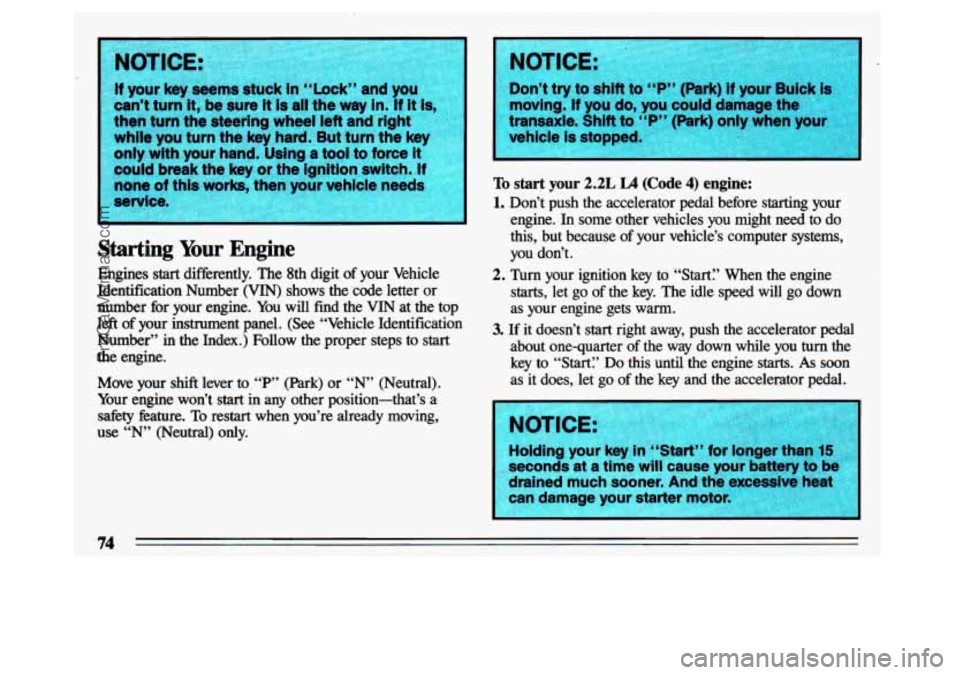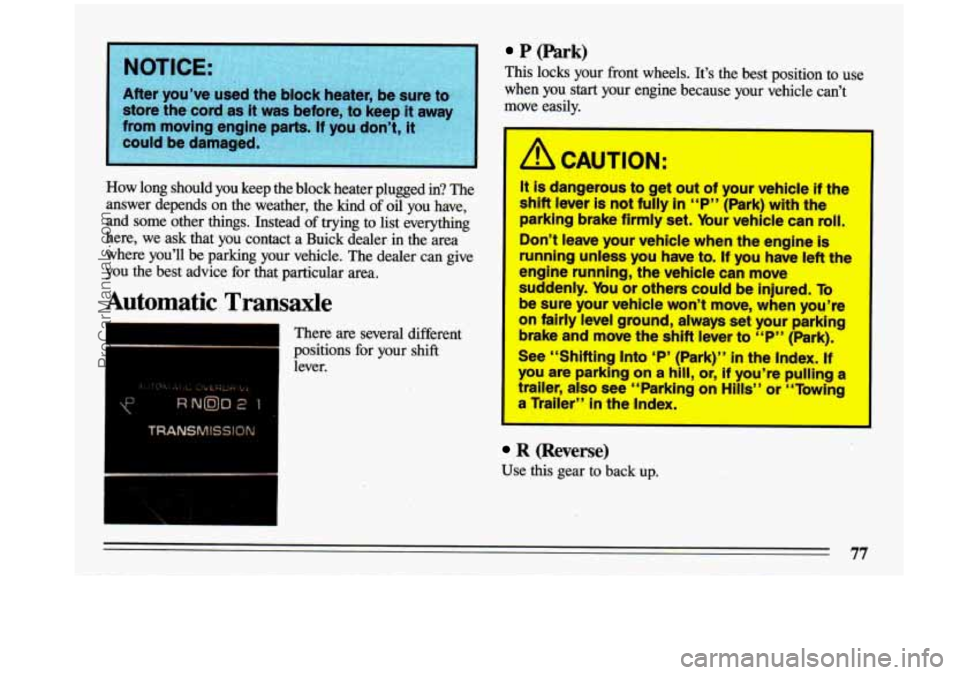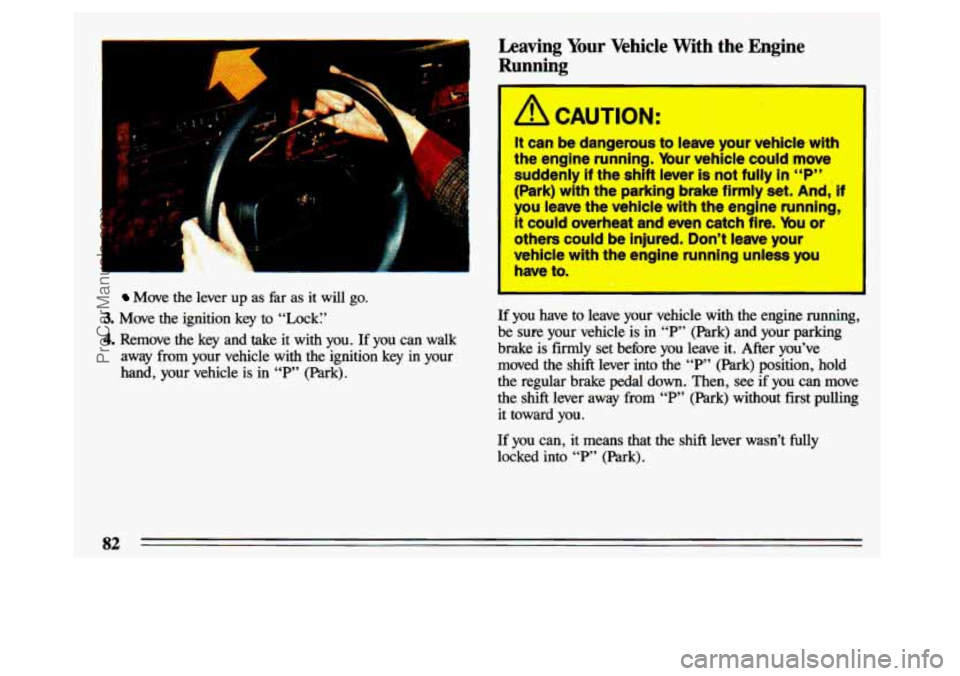Page 76 of 324

I I.
If your key &ems suwn in ‘‘Lu~n IU Y~U
can’t turn it, be sure it is all the way in. If it is,
then turn the steering wheel left and right
while you turn the key hard. But turn the key
only with your hand. Using
a tool to force it
could break the key or the ignition switch. If
none
of this works, then your vehicle needs
service.
I
Starting Your Engine
Engines start differently. The 8th digit of your Vehicle
Identification Number (VIN) shows the code letter or
number for your engine. You will find the VIN at the top
left of your instrument panel. (See “Vehicle Identification
Number” in the Index.) Follow the proper steps to
start
the engine.
Move your shift lever to
“P” (Park) or “N” (Neutral).
Your engine won’t
start in any other position-that’s a
safety feature.
To restart when you’re already moving,
use “N” (Neutral) only.
To start your 2.2L L4 (Code 4) engine:
1. Don’t push the accelerator pedal before starting your
engine. In some other vehicles you might need to do
this, but because
of your vehicle’s computer systems,
you don’t.
starts, let go of the key. The idle speed will go down
as your engine gets warm.
3. If it doesn’t start right away, push the accelerator pedal
about one-quarter of the way down while you turn the
key
to “Start;’ Do this until the engine starts. As soon
as it does, let go of the key and the accelerator pedal.
2. Turn your ignition key to “Start:’ When the engine
74
ProCarManuals.com
Page 77 of 324

4. If your engine still won’t start (or starts but then
stops), it could be flooded with too much gasoline.
Try pushing your accelerator pedal all the way to the
floor and holding it there as you hold the key in
“Start” for about three seconds. If the car starts
briefly but then stops again, do the same thing, but
this time keep the pedal down for five or six seconds.
This clears the extra gasoline from the engine.
To start your 3300 V6 (Code N) engine:
1. Don’t push the accelerator pedal before starting your
engine. In some other vehicles you might need to do
this, but because of yourwehicle’s computer systems,
you don’t.
starts, let go of the key. The idle
speed will go down
as your engine gets warm.
2. Turn your ignition key to “Start? When the engine
3. If it doesn’t start right away, push the accelerator pedal
about one-quarter of the way down while you turn the
key to “Start;’ Do
this until the engine starts. As soon
as it does, let go of the key and the accelerator pedal.
seconds-at a time will cause your battery to b
drained much sooner. And the excessive hea
can damage your starter motor,
4. If your engine still won’t start (or starts but then
stops), it could be flooded with too much gasoline.
Try pushing your accelerator pedal all the way to the
floor and holding it there as you hold the key in
“Start” for about
15 seconds. This clears the extra
gasoline from the engine. Turn the ignition
key to
“Off’ Wait 10 seconds, then repeat Step 3.
I
I
75
ProCarManuals.com
Page 78 of 324
~ Driving T -ough Deep Standing Water
orktanding
water, water can come in through
your engine’s air intake and badly damage your en ine. If ou can’t avoid dee uddles
or stan
slowly.
Engine Block Heatel lada only)
In very cold weather, 0°F (-HOC) or colder, the engine
block
heater can help. You’ll get easier starting and better
fuel economy during engine warm-up.
To use the block heater:
1. Turn off the engine.
2. Open the hood and unwrap the electrical cord.
3. Plug it into a normal, grounded UC olt outlet.
I I
Plugging the cord into an ungrounded outlet I
could cause an electrical shock. Also, the
wrong kind of extension cord could overheat
and cause a fire.
You could be seriously
injured. Plug the cord into a properly
grounded three-prong 110-volt outlet.
If the
cord won’t reach, use a heavy-duty three-
prong extension cord rated for at least 15
amps.
ProCarManuals.com
Page 79 of 324

NOTICE:
After you’ve
How long should you keep the block heater plugged in? The
answer depends on the weather, the kind of
oil you have,
and some other things. Instead of trying
to list everything
here, we ask that you contact a Buick dealer, in the area
where you’ll be parking your vehicle. The dealer can give
you the best advice for that particular area.
Automatic .Transaxle
There are several different
positions for your
shift
lever.
P (Park)
This locks your front wheels. It’s the best position to use\
when you
start your engine because your vehicle can’t
move easily.
I- -
I a CAUTION:
It is dangerous to get out of your vehicle if the
shift lever is
not fully in “P” (Park) with the
parking brake firmly set.
Your vehicle can roll.
Don’t leave your vehicle when the engine is
running unless you have to. If you have left the
engine running, the vehicle can move
suddenly. You
or others could be injured. To I
be sure your vehicle won’t move, when you’re
on fairly level
ground, always set your parking
brake and move the shift lever to “P” (Park).
See “Shifting
Into ‘P’ (Park)” in the Index. If
you are parking
on a hill, or, if you’re pulling a
trailer, also see “Parking
on Hills” or “Towing
a Trailer”
in the Index.
R (Reverse)
Use this gear to back up.
ProCarManuals.com
Page 80 of 324

f, ‘,,moving forward could damage your transaxle,
to
“R” only after your vehicle is stopped
To rock your vehicle back and forth to get out of snow,
ice or sand without damaging your transaxle, see “If
You’re
Stuck: In Sand, Mud, Ice or Snow’’ in the Index.
N (Neutral)
In this position, your engine doesn’t connect with the
wheels.
To restart when you’re already moving, use
“N” (Neutral)
only. Also, use “N” when your vehicle is
being towed.
I A CAUTION:
Shifting out,of “P” (Park) or “N” (Neutral)
while your engine is “racing” (running at high
speed) is dangerous. Unless your foot is firmly
on the brake pedal, your vehicle could move
very rapidly. You could lose control and
hit
people or objects. Don’t shift out of “P” (Park)
or “N” (Neutral) while your engine
is racing.
@ (Automatic Overdrive)
If your automatic transaxle has automatic overdrive, this
position is for normal driving. If you need more power
for passing,
and you’re:
- Going less than about 35 mph (56 km/h), push your
- Going about 35 mph (56 km/h) or more, push the
accelerator pedal about halfway down.
accelerator all the way down. You’ll
shift down to the
next gear and have more power.
D (Third Gear)
If your automatic transaxle does not have Overdrive, this
position is for normal driving, at all
speeds, in most
street
and highway situations.
78
ProCarManuals.com
Page 83 of 324
Shifting Into “P” (Park)
,3
/i CAUTION: ~
It can be dangerous to get out of your vehlcle
if the shift lever is not fully in “P” (Park) with ,
the parking brake firmly set. bur vehicle can -.
roll.
If you have left the engine runnin.g, the vehicle
can move suddenly. ybu
or others could be
injured. To be sure your vehicle won’t inwe,
when you’re on fairly level ground, Use the ‘
steps that follow. If you are parking on a hill,
or if you’m pulling a trailer, also see. “Parking
on Hills” or “Towing B Trailer” in the Index.
Steering Column Shift Lever
1. Hold the brake pedal down with your right foot and set
the parking brake.
2. Move the shift lever into the “P” (Park) position like
this:
Pull the lever toward you.
81
ProCarManuals.com
Page 84 of 324

F- LA- 1
Move the lever up as far as it will go.
3. Move the ignition key to “Lock:’
4. Remove the key and take it with you. If you can walk
away from your vehicle with the ignition key in your
hand, your vehicle is
in “P” (Park).
Leaving Your Vehicle With the Engine
Running
It can be dangerous to leave your vehicle with
the engine running. Your vehicle could move
suddenly if the shift lever is not fully in
“P”
(Park) with the parking brake firmly set. And, if
you leave the vehicle with the engine running,
it could overheat and even catch fire. Ybu or
others could be injured. Don’t leave your
vehicle with the engine running unless you
have to.
If you have to leave your vehicle with the engine running,
be sure your vehicle
is in “P” (Park) and your parking
brake is firmly set before you leave it. After you’ve
moved the shift lever into
the “P” (Park) position, hold
the regular brake pedal down. Then, see if you can move
the shift lever away from
“P” (Park) without first pulling
it toward you.
If you can, it means that the shift lever wasn’t hlly
locked into
“P’ (Park).
82
ProCarManuals.com
Page 85 of 324
Parking Over Things That Burn Engine Exhaust
a CAUTION:
Things that can burn could touch hot exhaust
parts under your vehicle and ignite. Don’t park
over papers, leaves, dry grass or other things
that can
burn.
A CAUTION:’ ‘
Engine exhaust can kill. It contains the gas
carbon monoxide (CO), which you can’t see or
death.
You might have exhaust coming in if:
Your exhaust system sounds strange or
Your vehicle gets rusty underneath.
I Your vehicle was damaged in a collision.
Your vehicle was damaged when driving over
I high points on the road or over road debris.
Repairs weren’t done correctly.
Your vehicle or exhaust system had been
If you
ever suspect exhaust is coming into
your vehicle:
Drive it only with all the windows down to
Have it fixed immediately.
I smell. It can cause unconsciousness and
different.
modified improperly.
blow out any
CO; and
ProCarManuals.com